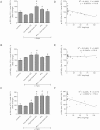Pioglitazone Enhances the Beneficial Effects of Glucocorticoids in Experimental Nephrotic Syndrome
- PMID: 27142691
- PMCID: PMC4855145
- DOI: 10.1038/srep24392
Pioglitazone Enhances the Beneficial Effects of Glucocorticoids in Experimental Nephrotic Syndrome
Abstract
Glucocorticoids are the primary therapy for nephrotic syndrome (NS), but have serious side effects and are ineffective in ~20-50% of patients. Thiazolidinediones have recently been suggested to be renoprotective, and to modulate podocyte glucocorticoid-mediated nuclear receptor signaling. We hypothesized that thiazolidinediones could enhance glucocorticoid efficacy in NS. We found that puromycin aminonucleoside-induced proteinuria in rats was significantly reduced by both high-dose glucocorticoids (79%) and pioglitazone (61%), but not low-dose glucocorticoids (25%). Remarkably, pioglitazone + low-dose glucocorticoids also reduced proteinuria (63%) comparably to high-dose glucocorticoids, whereas pioglitazone + high-dose glucocorticoids reduced proteinuria to almost control levels (97%). Molecular analysis revealed that both glucocorticoids and pioglitazone enhanced glomerular synaptopodin and nephrin expression, and reduced COX-2 expression, after injury. Furthermore, the glomerular phosphorylation of glucocorticoid receptor and Akt, but not PPARγ, correlated with treatment-induced reductions in proteinuria. Notably, clinical translation of these findings to a child with refractory NS by the addition of pioglitazone to the treatment correlated with marked reductions in both proteinuria (80%) and overall immunosuppression (64%). These findings together suggest that repurposing pioglitazone could potentially enhance the proteinuria-reducing effects of glucocorticoids during NS treatment.
Figures




References
-
- MacHardy N. et al. Management patterns of childhood-onset nephrotic syndrome. Pediatr Nephrol. 24, 2193–2201 (2009). - PubMed
-
- Ponticelli C. et al. Can prolonged treatment improve the prognosis in adults with focal segmental glomerulosclerosis? Am J Kidney Dis. 34, 618–625 (1999). - PubMed
-
- Greenbaum L. A., Benndorf R. & Smoyer W. E. Childhood nephrotic syndrome–current and future therapies. Nat Rev Nephrol. 8, 445–458 (2012). - PubMed
-
- Sarafidis P. A., Stafylas P. C., Georgianos P. I., Saratzis A. N. & Lasaridis A. N. Effect of thiazolidinediones on albuminuria and proteinuria in diabetes: a meta-analysis. Am J Kidney Dis. 55, 835–847 (2010). - PubMed
-
- Liu H. F. et al. Thiazolidinedione attenuate proteinuria and glomerulosclerosis in Adriamycin-induced nephropathy rats via slit diaphragm protection. Nephrology (Carlton). 15, 75–83 (2010). - PubMed
Publication types
MeSH terms
Substances
Grants and funding
LinkOut - more resources
Full Text Sources
Other Literature Sources
Medical
Research Materials
Miscellaneous

